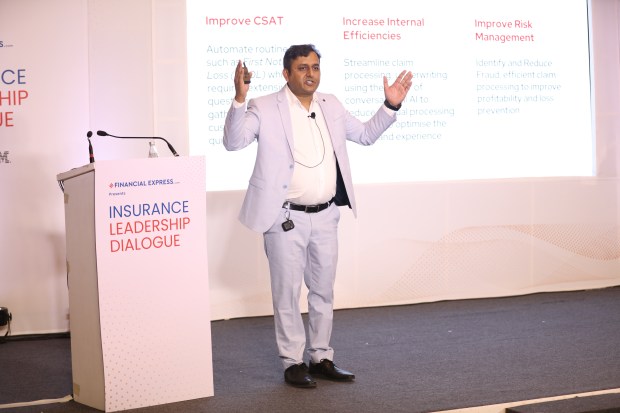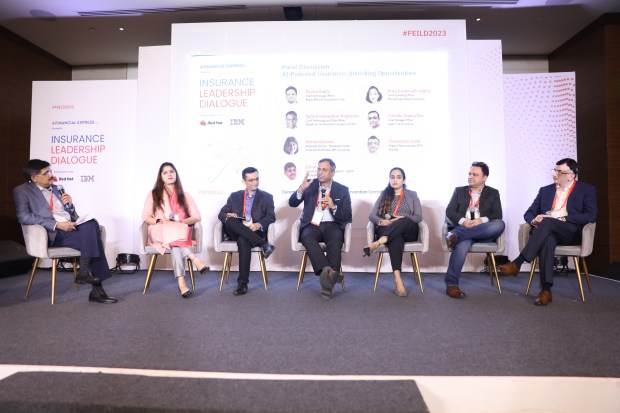Generative AI is fast making its way into multiple business processes and its use case in the insurance sector is taking centrestage. FinancialExpress.com in association with Red Hat and IBM organised an Insurance Leadership Dialogue to understand how the industry is adopting this technology and what opportunities and challenges it faces in this journey.
Headlining the event, Vikram Pagaria, Joint Director, National Health Authority (NHA), pointed out that generative AI was bound to pick up. “Like when Aadhaar was rolled out, it took time to find all the use cases, similarly Generative AI will have its role to play,” he said.
He said that with the National Health Claims Exchange being set up, the NHA and IRDA would use AI extensively. For instance, the Pradhan Mantri Jan Arogya Yojna (PM-JAY), a scheme that provides insurance to the underprivileged, uses AI-based methods in claims processing, and discerning the types of documents being uploaded and their quality.
Speaking about emerging trends, growth and how AI is impacting the insurance sector, Anuj Mittal Head, Specialist Sales – Emerging Technologies, Red Hat India and South Asia said: “The insurance sector has grown about 14x in the past 20 years. India’s share in life insurance was the maximum, but today about Rs 267,000 crore is the business being generated in India from the non-life sector.” Yet, in India, health coverage is only about 37% even with NHA push and crop insurance is only 27% despite state government funding. Mittal added that there is huge opportunity to be tapped with significant headroom for growth, setting the tone for the leadership dialogue to follow.

AI-powered insurance: Unlocking Opportunities
A panel of experts and practitioners got together to discuss AI-powered insurance – how it can unlock opportunities. The panel included: Pankaj Gupta, Chief Technology Officer, Bharti AXA Life Insurance; Priya Deshmukh-Gilbile, Chief Operating Officer, ManipalCigna Health Insurance; Reena Khemani, Associate Partner – Insurance Cluster, India and South Asia, IBM Consulting; Sankaranarayanan Raghavan, Chief Technology and Data Officer, IndiaFirst Life Insurance Company; Srinidhi Shama Rao, Chief Strategy Officer, Aegon Life Insurance and Chintamani Joshi, Head of Technical sales BFSI, Red Hat.
Each of the representatives of the companies on the panel discussed the use cases, the deployment level, and diffusion of AI and generative AI in their respective organisations and how they viewed the landscape from their vantage points. The use of open-source technologies and their role in lowering operational costs and increasing chances for more transparent solution outcomes was also discussed. A common thread was their perspectives on the state of internal preparedness that organisations need to put in place for a future with AI.
Speaking about his experience with fraud detection and prevention, Srinidhi Shama Rao of Aegon Life Insurance said AI can help mitigate fraud and to help reduce cost and time. “We started working on use cases predominantly from the underwriting side and with fraud analytics, which is today being used extensively in our underwriting process,” said Rao.
Others echoed their thoughts on leveraging the power of AI in other verticals with Pankaj Gupta of Bharti AXA Life Insurance, pointing to how almost every vertical of an organisation is today exposed to AI. He said: “One should start with a business problem, focus on data quality, data augmentation strategies, build the data sets and then implementing AI will become easier.” It is therefore with reason that Reena Khemani of IBM Consulting sees generative AI as “sowing the seeds of empowerment at each of the stages across the lifecycle of an insurance policy.”
The heightened need for AI-powered insurance was also aided by the possibilities to expand the boundaries of the data that is available, leverage these to build models, and through them get better insights (with generative AI playing a crucial role here). This would ensure not only greater convenience and better experience for customers, it would also help stay engaged with them and drive both upselling and cross-selling.
To help traverse better and more efficiently in this journey, Chintamani Joshi from Red Hat saw the inevitable role of a tech player, and pointed to the use cases being referred to by the speakers.
Joshi said: “All of this works when there is a strong platform to work on because AI requires processing of lot of data, building the model, training, testing the model and taking corrective actions whenever there are deviations happening and it is here that we come in as a tech provider and playing the role of an enabler by providing the platform that is optimised to meet the workload requirements.”
The panellists felt it was crucial to get the organisations ready and adequately prepared internally and wherever required, partner with technology players. A useful approach in this was identified as one when the issue is approached from the consumption side with the consumer being made aware of the new possibilities and in turn triggering demand for better solutions.
However, to leverage the opportunities in this space, emphasis and focus first on the business problem was inescapable with an eye clearly on data quality. Also, in times when AI is inescapable and generative AI was to only make life easier for enterprises, the insurance industry could not afford to stay aloof.

AI and innovation in insurance: What’s hampering AI adoption at scale?
In fact, the insurance sector has been slowly and steadily adopting AI in various areas of its business while working in a highly regulated framework. Citing an example, Anu Chaudhuri Ghosh, Head- Marketing Star Union Dai-ichi Life Insurance, said: “There is a lot of servicing aspect and cross-selling that happens. One of the primary things that AI has helped us do is to mask all the PII data. Since we have a lot of banking customers, there is a lot of governance around how data flows and what kind of policies are put in place.”
With the amount of data available, data security is one of the areas that companies need to keep an eye on. Hiren Pandya, Chief Information Security Officer, Reliance Nippon Life Insurance, said: “You need to set the context for the data that you want to use. How do you store that data? Do you want to anonymise the data or keep it open? You have to define what data you’ll collect, what is the purpose, and for how long you will store it.”
Personalisation of product offerings is another area where insurers are dealing with customer data while ensuring the quality of the data is maintained when using AI to tailor products. “Personalisation to me is knowing enough about the customer, to be able to help him to make informed decisions. We need clean, hygienic, and meaningful data. It should not be garbage in, garbage out. You can’t expect AI engines to do magic if you feed them garbage,” opined Sumeet Aggarwal, Chief Technology Officer, ManipalCigna Health Insurance Company.
Rachit Sahai, Client Partner – Insurance Cluster, India and South Asia, IBM Consulting pointed out that it’s all about training the AI model in the right way, especially in a multi-lingual society like India. He said: “I want to break it into two parts. Are machines understanding the question that is being asked? And are they giving the right answer? For that, you can use a large language model for your bot to have a larger data set to work with. But for the answer, it has to be precise based on your insurance product information and customer information.”
The insurance industry is working with industry-level data, while companies are also working with customer data for personalisation and improved product offerings, while staying within policy regulations and integrating technology with legacy systems.
Vaibhav Malekar, Head – Corporate Commercial – West at Red Hat pointed out “AI which is confined to one kind of functionality is not enough to get the entire vision or objective. How an AI performs depends on the entire ecosystem. Here we are talking of legacy and existing applications and integration plays a very important role. In such a system we can’t have a siloed approach to security, it has to be continuous.”

The emphasis on data security, of course, raises cost as a concern. However, Nilesh Mejari, Chief Financial Officer, Universal Sompo General Insurance Company Ltd, said AI should not be seen as a cost centre. “AI is not a cost, it is an investment. Over a period of time it is going to improve your efficiency and improve your business growth, which will strengthen your P&L,” he pointed out.
Summing up, he exclaimed: “Money saved is money earned.”









